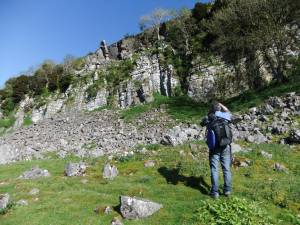|
| *****SWAAG_ID***** | 969 |
| Date Entered | 21/12/2016 |
| Updated on | 21/12/2016 |
| Recorded by | Tim Laurie |
| Category | Tree/Shrub Record |
| Record Type | Botanical HER |
| SWAAG Site | Ellerton Moor |
| Site Access | Army Range |
| Location | Ellerton Scar |
| Civil Parish | Ellerton Abbey |
| Brit. National Grid | |
| Geology | Isolated stack detached from the vertical face of a sheer cliff formed from the Main Limestone. |
| Record Name | Ellerton Scar.Two fine prostrate junipers (Juniperus communis ssp. nana). Swaledale's least and most ancient woody plants: |
| Record Description | These two prostrate junipers provide a complete contrast to the 'mighty' Native Yew whose trunk is in excess of of 5.00m girth recorded on the preceding SWAAG Database Record. These two low-growing forms of Juniper grow on the inaccessible summit of an isolated stack of limestone detached from the front of Ellerton Scar. The prostrate form of juniper carpets the summit plateaux of the Cairngorms and will be familiar to those who have hiked across many other exposed and stony high mountain summits in Northern Upland Britain. These junipers or their direct ancestors may have colonised the front edge of Ellerton Scar during the early Post Glacial Period.
The prostrate form of Juniper is recognised by its carpeting habit and by the the needle like small leaves not exceeding 10mm in length*1.5mm wide.
|
| Dimensions | 30cm (1ft.) in height and less than 1 metre width estimated |
| Additional Notes | Junipers, including this the prostrate, ground carpetting form of juniper, were among the earliest shrubs to colonise Britain during the first period of climatic warming following the final retreat of the glaciers.During subsequent periods, junipers were almost certainly more widespread throughout Swaledale. I have recorded Junipers at more than 40 separate localities in Swaledale. These Swaledale records include at least six areas of juniper scrub, the largest of these areas being the Harkerside Junipers. Most Juniper localities are however of less than five isolated shrubs. Single ancient Junipers with serpentine twisted and coiled branches, sole survivors of a population more widespread are found at remote waterfalls, often in company with aspen groves.
The 100,000th Ancient Tree to be recorded on the Woodland Trust Ancient Tree Inventory is an ancient juniper located in a small stand of similar ancient Junipers above Spring End in Swaledale.
Prostrate Form of Juniper have been recorded at several other localities in Swaledale, notably on Oxnop Scar and at How Edge Scars.
NOTE! Beware! Danger of Death! These cliffs are generally pathless except for sheep tracks and are extremely dangerous especially to anyone who is inexperienced in climbing and who suffers from vertigo.
|
| Image 1 ID | 7087 Click image to enlarge |
| Image 1 Description | Ellerton Scar.The two prostrate junipers grow close together on the summit of the detached limestone stack. |  |
| Image 2 ID | 7088 Click image to enlarge |
| Image 2 Description | The stack photographed from above. |  |
| Image 3 ID | 7089 Click image to enlarge |
| Image 3 Description | The locality of the two prostrate Junipers photographed from the sheep track at the top of the cliff by Edward (Eddie) Parker, Author of the highly recommended 'Ancient Trees. Trees that live for a thousand years.' Published by Batsford on behalf of Kew, 2012. Eddie has photographed and published many books on the World's most notable Trees. |  |
| Image 4 ID | 7090 Click image to enlarge |
| Image 4 Description | Ellerton Scar possesses very many wonderful specimen yews and other trees and is surely one of the most beautiful of all the limestone Scars in the Yorkshire Dales |  |
| Image 5 ID | 7091 Click image to enlarge |
| Image 5 Description | The locality of the two prostrate Junipers being photographed from the sheep track at the top of the cliff by Edward (Eddie) Parker, Photographer of the World's most notable Trees. |  |
| Image 6 ID | 7092 Click image to enlarge |
| Image 6 Description | Ellerton Scar . Two prostrate form Junipers. Detail of the foliage. |  |





